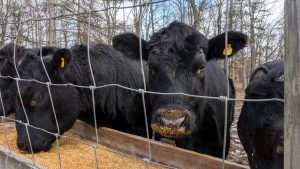Seeds Canada voted down by CSGA
AMALGAMATION OF SEED GROUPS ON HOLD

IN A CONVINCING 414 to 337 vote, members of the Canadian Seed Growers’ Association (CSGA) chose not to amalgamate with four other organizations to create Seeds Canada. Voting took place starting in mid-July and wrapped up at a virtual meeting on August 27, 2020.
Jonathan Nyborg, past President of the CSGA, was a key leader in the negotiations that led to the Seeds Canada proposal.
“While everyone involved was hoping for a yes vote, we were a bit surprised about the level of support against amalgamation,” he says.
Members of the four other seed organizations – Canadian Seed Trade Association, the Canadian Seed Institute, the Commercial Seed Analysts Association of Canada and the Canadian Plant Technology Agency – had already voted to amalgamate.
While it continues to work through its options regarding the vote, the CSGA board of directors is developing a transition plan, and together with staff, will work to improve the organization. With a focus on professional development for members, new technology and seed regulation modernization, the transition will be guided by the CSGA 2017-2023 Strategic Plan.
WHAT WOULD SEEDS CANADA HAVE LOOKED LIKE?
The idea for Seeds Canada was to have one board with representation from all the different sectors – developers, growers, seed testing, and seed trade – and representation from across the country. The membership would have been made up of businesses such as seed farms, companies and laboratories, all with voting rights. Professionals such as analysts, growers, plant breeders, and consultants would not have a vote, nor would affiliate members such as international partners and suppliers.
Supporters say that the new organization would have been more efficient in terms of service delivery. It would also have increased industry competitiveness, engendered greater collaboration, and provided one industry voice to government lobbying efforts.
“I think growers were worried they’d lose seats on the board – the way it works now is that members of the provincial branches put forward candidates to represent them on the national board,” he says. “With Seeds Canada, growers wanted to see member representation continue.”
When asked about the low number of votes – only 751 out of a CSGA membership of 3,500, Nyborg says that a 22 per cent turnout is actually quite high for the organization.
In an effort to educate members on the Seeds Canada proposal, Nyborg says CSGA held 12 virtual town halls to answer questions about the amalgamation. During those meetings, members expressed concerns with the time of year of the vote, that growers would lose their voice, that there was not enough detailed budget information, and a misunderstanding that the Seed Variety Use Agreement (SVUA) was tied directly with amalgamation.
“There’s really no ideal time of year to have the vote for farmers – there’s no real let-up for us,” he says, adding that he felt that members had ample time to make an informed decision between mid-July when the information packages were sent out to the end of August.
Some opinion pieces written before the vote warned that the amalgamation would drive up the cost of seed – good for the seed industry, but not so good for commercial farmers. However, Nyborg doesn’t think that would have happened.
“The price of seed is the price of seed – whether it’s bin-run, certified or common – we wouldn’t have seen any major changes,” he says.
Ellen Sparry, president of the Canadian Seed Trade Association, agrees.
“Pricing comes down to market-driven considerations – it wouldn’t be any more of an issue than it is now,” she says.
She also says that the SVUA was not linked to the amalgamation vote. The trailing royalty model was endorsed by Seed Synergy, an umbrella group representing six seed organizations, including CSGA. Essentially, the model would allow breeders, if they chose, to set a fee on farm-saved seed to account for the investments in research needed to bring the variety to market.
If a farmer chose to buy certified seed of a protected variety, they would sign an agreement, pay the fee, and declare each year whether harvested grain was saved for seed use the next year. The amount of that seed would be verified, and the producer would get an invoice for every year that the saved seed is grown. Proceeds would be returned to the breeders.
The model is currently being piloted with several wheat and soybean varieties by the Canadian Plant Technology Agency.
ONE VOICE
Sparry feels that having a united voice would have been one of the big pluses of Seeds Canada.
“Industry and some of the growers wanted to be better aligned in order to bring issues forward to government – rather than five different voices,” she says.
She cites government cutbacks as ‘an unfortunate part of where we are,’ and that the need to have public-private partnerships is now an ongoing part of life.
“It’s a cleaner process to have everyone move together as one group,” she says. “For example, C&M Seeds is a member of three different organizations – it makes sense to consolidate.” Sparry is the general manager at C&M Seeds.
She also says the industry is currently fractured in terms of where to go to get information – questions sometimes get passed from one place to another before they get answered.
Seed growers such as Lyndon Stoll, who wrote an opinion piece in the Western Producer, were worried about how multinationals stood “to gain even more profit at the expense of the seed grower and commercial producer.”
Sparry disagrees and says that the way it was structured, and how directors would be elected to the board, each business member would get one vote – whether they are a multinational, a sole proprietor or a smaller player like C&M Seeds.
“I don’t feel that I’m being overwhelmed by a multinational,” she says.
NEXT STEPS
Both Sparry and Nyborg say that moving forward, their respective boards need time to regroup and think through next steps.
“We need to take some time to consider our options,” Sparry says, adding that they can’t take too much time, or the momentum behind the amalgamation, which has been in the works for more than four years, may sputter. She says that, if the four remaining organizations decide to go ahead with the merger, the proposal would need to be updated and another vote taken with each association’s memberships.
In a letter to the membership, current CSGA President Joe Rennick put two basic options on the table:
“Either abandon efforts to achieve a consolidation of seed sector organizations and focus on becoming the best version of ourselves possible (CSGA 2.0) or re-engage with our amalgamation partners with a view to reaching a new Seeds Canada agreement with broader member appeal. Either way, it is important to note that our amalgamation partners must also reflect and decide on their respective organizations’ next steps. The option we choose will depend as much on our partners as it does on CSGA.” •
Other stories on amalgamation:
Manitoba Crop Alliance
The new Cereals Canada





















